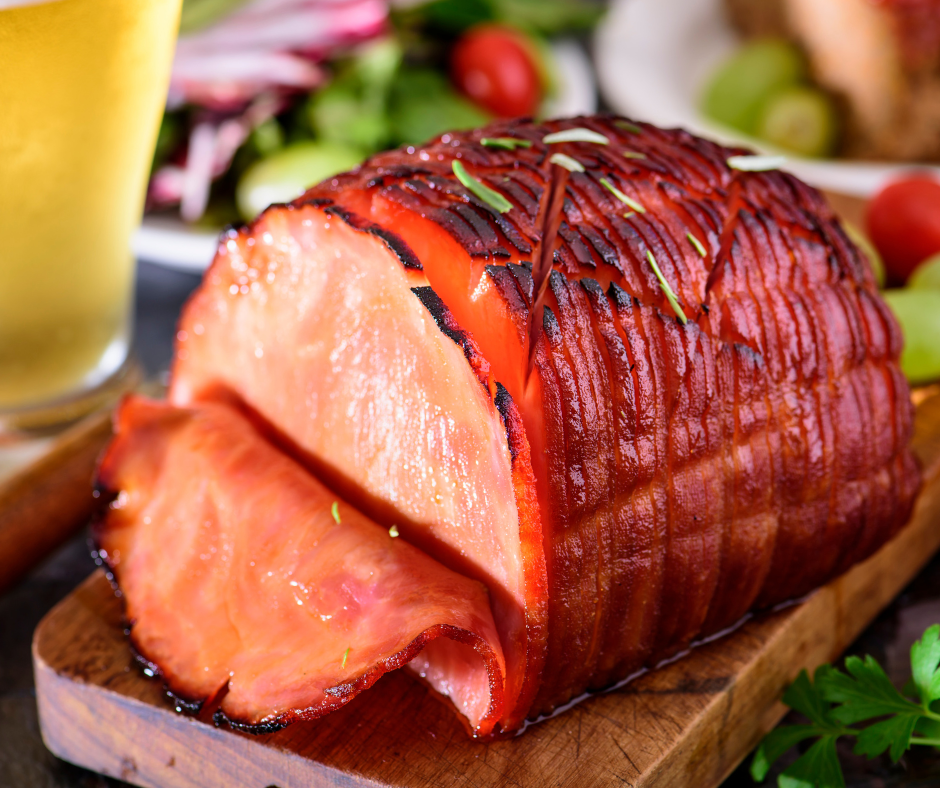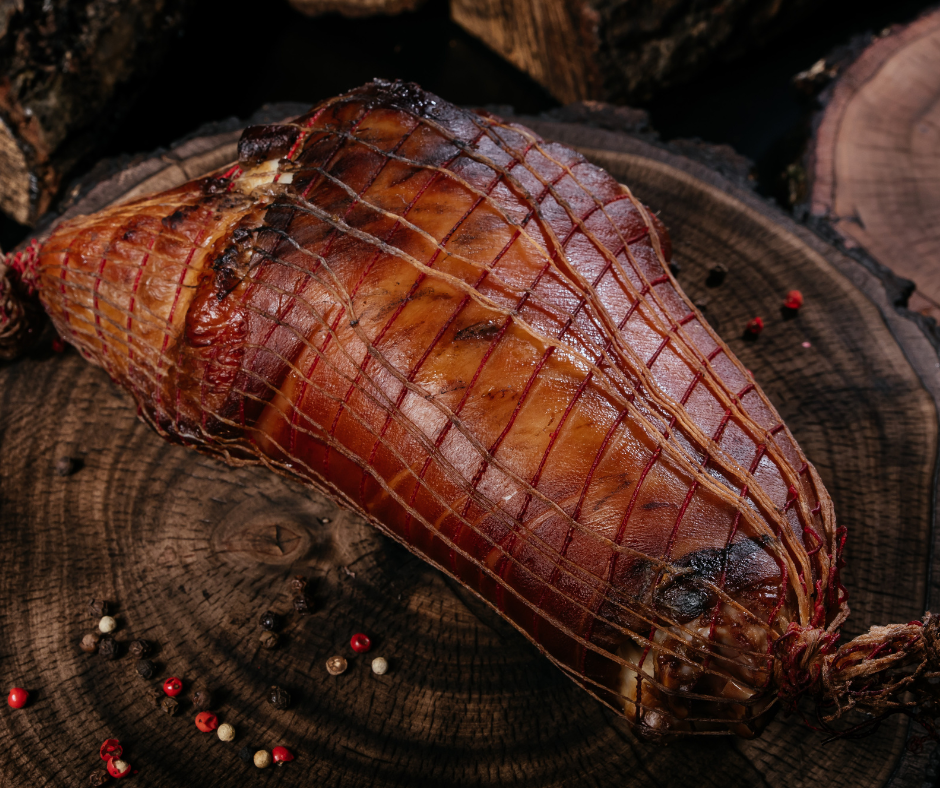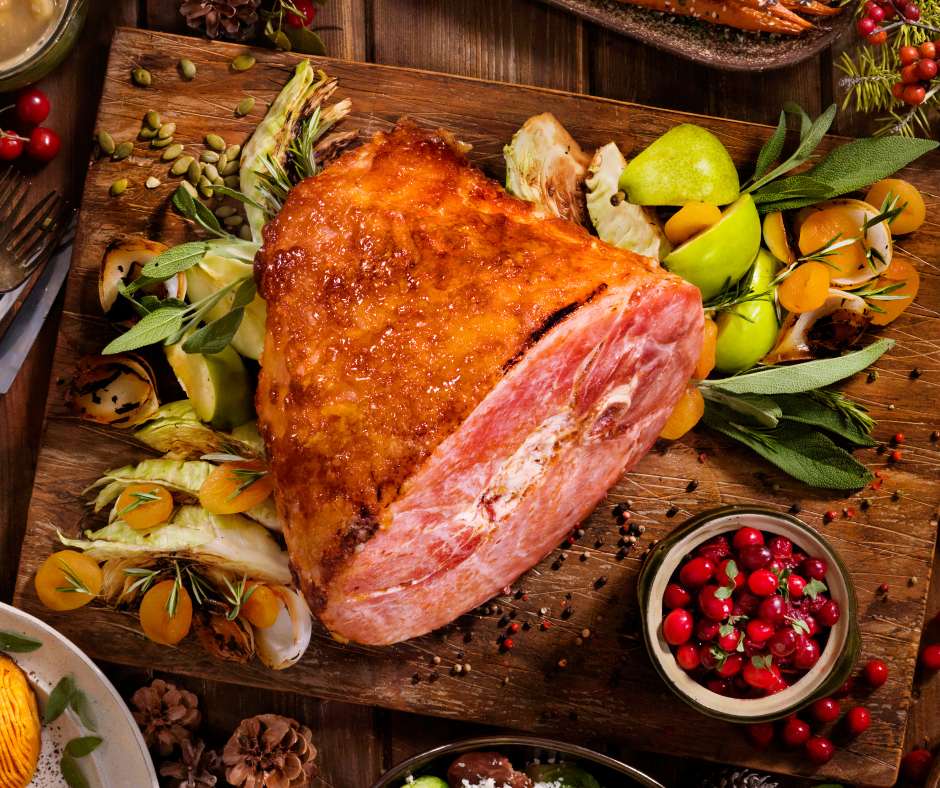Introduction
Many people often use the terms interchangeably regarding ham and pork. However, it’s important to note that while ham is pork, not all pork is ham. Understanding the difference when comparing Ham vs Pork can help you make informed decisions in the kitchen. Let’s delve into the distinctions between ham and pork.
Explanation Of The Difference Between Ham And Pork
Ham is a specific cut of pork that comes from the thigh of the pig’s hind leg. It is typically cured and salted, giving it a distinct flavor profile. Hams are often available in a ready-to-eat form, making them convenient for quick and easy meals. On the other hand, pork refers to any part of a domesticated pig used for meat. Unlike ham, pork is typically raw and requires cooking before consumption.
One of the key differences when comparing Ham and Pork is their taste and texture. Due to the curing process, ham takes on a salty and smoky flavor that many people enjoy. It has a firm texture and can be sliced thinly for sandwiches or cubed for salads. Pork, on the other hand, has a milder flavor and a more tender texture. The pork taste can vary depending on the specific cut, with fattier cuts usually offering a richer flavor.
Cooking methods also vary between ham and pork. Since ham is usually cured, it is often prepared by roasting, baking, or slow-cooking to bring out its flavors and create a delicious crust. It can be glazed or paired with various seasonings and spices to enhance its taste. On the other hand, pork can be cooked in various ways, including grilling, pan-searing, and braising. It offers versatility in the kitchen and can be used in various dishes, from stir-fries to stews.
In summary, while ham is a specific cut of pork meat from the thigh of the pig’s hind leg, pork refers to any part of a domesticated pig used for meat. The main differences between the two lie in their curing process, taste, texture, and cooking methods. Understanding these distinctions can help you choose the right meat for your culinary needs and explore the diverse flavors and options that ham and pork offer.

What Is Ham?
Definition And Characteristics Of Ham
Ham is a specific pork meat cut from the thigh of the pig’s hind leg. It is known for its distinct flavor and texture, which is achieved through the curing process. Curing involves adding salt and other seasonings to the meat and allowing it to undergo a slow drying process. This process not only adds flavor but also helps preserve the meat.
Ham has a firm texture that can be sliced thinly for sandwiches or cubed for salads. It is often enjoyed for its salty and smoky taste resulting from curing. Depending on the type of ham, it can vary in flavor and texture. Some hams taste sweeter, while others have a more intense smokiness.
Different Types Of Ham
Several different types of ham are available, each with its unique characteristics and preparation methods. Some popular types of ham include:
- Honey Glazed Ham: This type of ham is coated with a sweet honey glaze, which adds a touch of sweetness to the meat. It is often served as the centerpiece of holiday meals or special occasions.
- Black Forest Ham: Originating from the Black Forest region of Germany, this ham is known for its rich and smoky flavor. It is traditionally dry-cured with salt, garlic, coriander, and other spices.
- Prosciutto: This Italian dry-cured ham is thinly sliced and often enjoyed as part of antipasto platters or wrapped around fruits or vegetables. It has a delicate and slightly salty flavor.
- Country Ham: Popular in the southern United States, country ham is salt-cured and aged for an extended period. It has a robust, salty flavor and a firm texture.
- Serrano Ham: Hailing from Spain, Serrano ham is similar to prosciutto but is saltier and has a bolder flavor. It is often served thinly sliced and enjoyed with melons or in tapas dishes.
These are just a few examples of the diverse range of ham available. Each type offers its distinct flavor profile and can be used in various dishes, from sandwiches and salads to pasta and pizza.
Understanding the differences between ham and other cuts of pork is essential for making informed decisions in the kitchen. Whether you’re looking for a salty and smoky flavor or a more tender and mild taste, exploring the world of ham can add a delicious twist to your meals. So, the next time you’re shopping for meat, consider trying different types of ham and discover the flavors and textures that suit your culinary preferences.
What Is Pork?
Pork is a type of meat from any part of a domesticated pig. It is the raw, unprocessed meat that is ready to be cooked. Pork is versatile and used in various dishes, including sausages, bacon, and pulled pork.
Definition And Characteristics Of Pork
Pork is derived from the pig, specifically from hogs between six months and one year old. It is typically sold in raw form and can be prepared in various ways depending on the desired dish. Pork has a mild flavor that can be enhanced with seasonings and marinades.
When it comes to texture, pork can vary depending on the cut. Some cuts, such as pork chops and tenderloin, are tender and lean, while others, like pork belly and shoulder, have more fat, resulting in juicier and flavorful meat.
Various Cuts Of Pork
Numerous pork cuts are available, each with its characteristics and cooking methods. Here are a few examples:
- Pork Chops: These cuts come from the loin and are known for their tenderness. They can be boneless or bone-in and are often grilled, pan-fried, or baked.
- Pork Tenderloin: This cut is lean, tender, and boneless. It is often marinated and roasted, grilled, or used in stir-fries.
- Pork Belly: This cut is rich in fat and is known for its delicious flavor. It is often used to make bacon but can also be slow-cooked or braised for crispy and succulent results.
- Pork Shoulder: Also known as pork butt, this cut is well-marbled with fat and is perfect for slow cooking, making it ideal for pulled pork or stews.
- Spare Ribs: These are the meaty cuts from the pig’s ribcage. They are often seasoned and grilled or baked until tender.
- Ham: Ham is a specific pork cut from the pig’s thighs. It is usually cured and salted, giving it a distinct flavor. Hams can be cooked and eaten or used in various dishes.
It’s important to note that while ham is a form of pork, not all pork is ham. Ham has a longer shelf life than other pork cuts, thanks to the curing and salting process.
In conclusion, pork is a versatile meat that can be used in various dishes, while ham is a specific cut of pork that has undergone a curing process. Understanding the differences between these meats and their various cuts allows for informed decisions regarding cooking and enjoying them.

Ham vs. Pork
When it comes to meat options, ham and pork are often confused with each other. However, several key differences are worth exploring when you compare Ham vs Pork. In this article, we will unpack the dissimilarities in their processing and preparation methods, as well as their shelf life and storage.
Processing And Preparation Methods
The main difference between ham and pork is their processing and preparation methods. In its raw form, pork is the meat that comes from any part of a domesticated pig. It is unprocessed and ready to be cooked. On the other hand, ham specifically refers to the hind leg of a pig that has been preserved through curing and smoking. This curing process involves adding salt, sugar, and other seasonings to the meat, which gives it a distinct flavor and texture. On the other hand, pork can be prepared in various ways depending on the desired dish, and its flavor can be enhanced with seasonings and marinades.
Shelf Life And Storage
Another significant difference between ham and pork is their shelf life and storage requirements. Due to the curing and smoking process, ham has a longer shelf life than other pork cuts. The preservation methods used in ham production ensure that it can be stored for extended periods without spoiling. It is important to note that once a ham has been sliced, its shelf life may be shorter than a whole ham.
On the other hand, pork, being in its raw form, has a shorter shelf life and requires proper storage to prevent spoilage. It is recommended to store pork in the refrigerator at temperatures below 40°F (4°C). It is also important to practice safe handling and cooking practices to avoid any foodborne illnesses associated with improperly stored or cooked pork.
Understanding these differences in processing, preparation, shelf life, and storage allows us to make informed choices when selecting cuts of meat for our recipes. Whether you’re looking for a tender and juicy cut of pork or craving the distinct flavor of ham, knowing these dissimilarities can help you make the right choice for your culinary endeavors.
In conclusion, ham and pork differ in processing, preparation methods, shelf life, and storage requirements. While pork is the raw meat obtained from various cuts of a domesticated pig, ham specifically refers to a pig’s cured and smoked hind leg. Considering these differences will enable you to make conscious decisions about the type of meat you prefer and how to incorporate it into your cooking. So whether you’re preparing a pork chop or savoring a slice of ham, you can relish these meats’ distinct characteristics and flavors.
Cooking And Culinary Uses
When it comes to cooking and culinary uses, ham and pork have their unique characteristics and techniques. Understanding the differences in the cooking methods and popular dishes of Ham vs Pork can help you make the most of these meats in your kitchen.
Different Cooking Techniques For Ham And Pork
When it comes to ham, the curing process it undergoes gives it a distinct flavor and texture. The most common way to cook ham is by baking it in the oven. This helps to bring out its smoky and salty flavors, resulting in a delicious and juicy dish. Roasting and glazing the ham with a sweet or savory sauce is also a popular technique, adding an extra layer of flavor.
On the other hand, pork offers a wide range of cooking possibilities. It can be roasted, grilled, sautéed, or even slow-cooked for different textures and flavors. Popular cuts of pork include pork chops, tenderloin, ribs, and shoulder. Each cut requires a different cooking method to bring out its best qualities. For example, pork chops are often pan-seared or grilled to achieve a juicy and tender result, while pork ribs are commonly slow-cooked or smoked to achieve fall-off-the-bone tenderness.
Popular Dishes Using Ham And Pork
Ham is a versatile meat that can be used in various dishes. It is often enjoyed as the centerpiece of holiday feasts, sliced and served alongside other traditional accompaniments. Ham can also add depth of flavor to soups, stews, and casseroles. It pairs well with pineapple, mustard, and cloves, creating a perfect balance of sweet and savory flavors.
With its different cuts and versatility, pork is found in a wide range of dishes worldwide. Pork tenderloin can be marinated and then grilled, making it a tender and flavorful option for a main course. Pulled pork, slow-cooked until it can be easily shredded, is a favorite for barbecue sandwiches and tacos. Pork belly, often prepared as a crispy and rich dish, is enjoyed in pork belly bao buns or crispy pork belly stir-fry.
In conclusion, ham and pork may come from the same animal, but they have distinct characteristics and uses in the culinary world. With its cured and smoky flavor, ham is commonly baked or glazed to enhance its distinct taste. On the other hand, pork offers a wide range of cooking techniques and can be enjoyed in various dishes. Whether savoring a slice of ham during the holidays or experimenting with different pork cuts, these meats offer unique flavors and textures that can elevate any meal.

Conclusion
Regarding Ham vs Pork, it’s important to understand the key differences between these meats. Ham is a specific cut of pork that comes from the pig’s hind legs, while pork refers to any meat derived from a pig. Ham is typically salted and preserved and often offered in ready-to-eat packages. On the other hand, pork is uncooked meat that can be used to make various dishes such as sausages, bacon, and pulled pork.
In terms of branding, businesses must invest in creating a unique identity that sets them apart from their competitors. Branding goes beyond just creating a logo and slogan; it involves developing a strong and reliable brand identity that resonates with the target audience. By leveraging values, stories, brand promises, and other assets, businesses can showcase their distinctiveness and create a point of difference.
Some best branding examples include companies like Apple, Nike, and Coca-Cola. These brands have crafted a unique identity that is instantly recognizable and resonates with their target audience. They have built a strong reputation based on their values, quality products, and innovative marketing strategies.
In conclusion, the importance of branding cannot be underestimated when differentiating your business in a crowded market. By developing a strong brand identity and leveraging your unique assets, you can stand out from your competitors and create a lasting impression on your customers. Remember, branding is not just about creating a logo; it’s about telling a story and connecting with your audience. So, invest in branding and watch your business soar to new heights.
FAQ: Ham vs Pork: Unpacking the Differences Between These Meats
Q: What is ham?
A: Ham is a specific pork meat cut from the pig’s hind leg. It is typically cured and salted, often available in a ready-to-eat form.
Q: What is pork?
A: Pork refers to the raw meat from any part of a domesticated pig. It is versatile and can cook various dishes like sausages, bacon, and pulled pork.
Q: Are ham and pork the same?
A: While all ham is pork, not all pork is ham. The main difference lies in how they are prepared and their specific cuts. Ham specifically comes from the pig’s thighs and undergoes curing and salting.
Q: Can you explain the appearance, taste, and texture differences when comparing Ham vs Pork?
A: Ham and pork have distinct appearance, taste, and texture differences. Ham has a pink color and a firmer texture, while pork can vary in color depending on the specific cut. Regarding taste, ham is typically salty and slightly sweet, whereas pork has a milder taste that various seasonings can enhance.
Q: Can ham and pork be used interchangeably in recipes?
A: While ham and pork can be used in similar dishes, they cannot always be substituted for each other due to their different flavors and textures. It’s best to follow specific recipe instructions to achieve the desired outcome.
Q: What about the shelf lives of ham and pork?
A: Ham typically has a longer shelf life compared to pork. This is because ham is cured and salted, which helps preserve it longer. Pork, on the other hand, is a fresh raw meat that needs to be cooked promptly or properly stored in the refrigerator.
Q: Is ham readily available in bone-in and boneless forms?
A: Yes, ham is commonly sold in both bone-in and boneless forms. Boneless ham is easier to prepare but can sometimes be dryer than bone-in ham.
Q: Are there any specific cooking recommendations for ham and pork?
A: Cooking methods for ham and pork can vary depending on the specific cut and desired dish. It is recommended to refer to cooking guides or consult a reputable source for specific recommendations on different pork cuts.
Q: Is ham processed meat?
A: Yes, ham is considered a processed meat product. It undergoes curing and salting processes to enhance its flavor and extend its shelf life. Pork, on the other hand, is raw meat that requires further processing before consumption.
Graham Bartlett, owner at Taco and Piña Mexican food, is all about bringing the authentic flavors of Mexico to your plate. With Graham Bartlett, you can tantalize your taste buds with mouthwatering tacos and delicious piña coladas, all in one place. Stay connected and never miss a beat as Graham Bartlett takes you on a culinary journey through vibrant Mexican cuisine. Join the community and discover the perfect blend of flavor, culture, and passion that Graham Bartlett brings to the table. Experience the essence of Mexico, one bite at a time, with Graham Bartlett.
